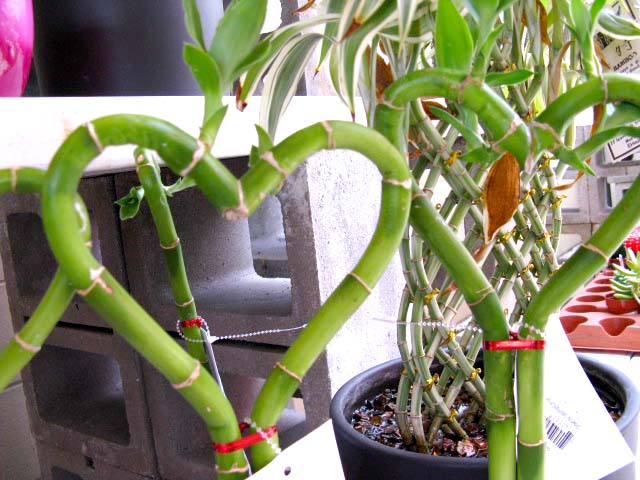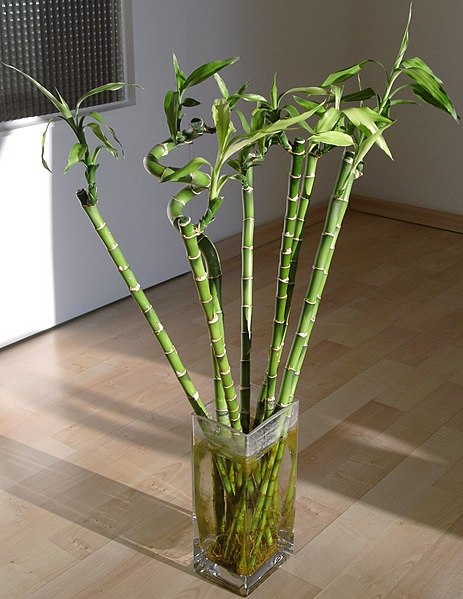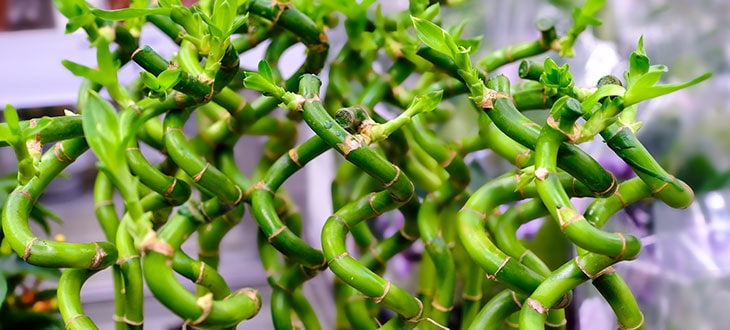Lucky Bamboo: The Plant That Attracts Luck And Prosperity
Lucky bamboo, scientifically known as Dracaena sanderiana, is a plant that is said to bring luck and prosperity to our homes. Not only is it a powerful energetic plant, but it is also extremely easy to care for.
The popularity of Dracaena sanderiana has increased in recent years among plant lovers and has become one of the most common houseplants in the world. It also has a long history in the traditional Chinese culture and in the practice of Feng Shui.
The lucky bamboo is both a widespread ornamental plant for living rooms, as well as for offices. At the same time, due to its symbolism and the potential to attract wealth and abundance in the life of anyone who owns it, it is also a popular choice for gifts.
Disclosure: This page contains affiliate links. This means that the owner of this website might be compensated for any qualifying purchases made via these links.
Contents
About The Lucky Bamboo Plant
Despite its common name and segmented appearance similar to bamboo plants, the lucky bamboo is not a true bamboo. Dracaena sanderiana plants belong to the Asparagaceae botanical family, while real bamboos belong to the family Poaceae.
It is a perennial plant, native to the tropical forests of Cameroon, Africa, and Southeast Asia, and distributed all over the world as an ornamental plant. Besides its well-known name of “lucky bamboo,” Dracaena sanderiana is also commonly known under names such as the Chinese water bamboo, friendship bamboo, water bamboo, Sander’s dracaena, ribbon plant, curly bamboo, etc.
A mature lucky bamboo plant does not typically exceed 39 inches (1 m) in height. Thus, it’s a relatively small plant that is suitable even for smaller rooms.
It has a long, lime green, smooth, upright, segmented stem, similar in aspect to bamboo plants. However, unlike the real bamboo’s stems which are typically hollow and woody, the stem of Dracaena sanderiana is fleshy. The young stems are often shaped into a variety of forms.

The leaves of lucky bamboo are green, twisted, and have a lanceolate shape. They are usually well-spaced and present in the superior part of the stems.
While in its natural habitat the lucky bamboo produces flowers, when kept indoors, as a houseplant, it will not.
Lucky Bamboo In Feng Shui
Lucky bamboo has been seen as a symbol of good fortune and wealth and used in the ancient Chinese traditional practice of Feng Shui for thousands of years.
Feng Shui is an old Chinese traditional practice that uses the elements and energies found in nature to harmonize individuals with their surroundings.
The adepts of this culture believe that through everything around us flows a vital energy called “qi” (also known as “chi” or “ki”).
It is said that the flow of these energies can affect someone’s life in either a good or a bad way. A harmonious flow of qi in your body can improve your health, boost your stamina, and have various positive effects. On the other hand, the blockages of this vital energy will lead to opposing and negative results.
Feng Shui concentrates on five elements found in nature, like earth, water, wood, metal, and fire. They are everywhere around us and interconnected, and in this culture, their presence impacts our day-to-day life in a positive or negative way.
The lucky bamboo plant is considered an energetic plant. It is thought that if used properly, it has the power to regulate the surrounding energies and thus attract various positive things into our lives. Not only the plant itself is important, but also its location in the house, as well as the number of plants.
How many lucky bamboos for good fortune?
There are some specific numbers that in Feng Shui have a special significance in attracting various beneficial energies. So the number of lucky bamboo stems in the same arrangement is never random.

Number of lucky bamboo stalks meaning
The symbolism of these numbers may differ from one source to another. In essence, all the numbers presented bring luck and positive aspects in one’s life, with the exception of the number 4, which in Chinese culture is an unlucky number.
1 stalk – Represents truth or commitment and is also a symbol of a prosperous life.
2 stalks – The number two is associated with love and relationships, family, or friendship.
3 stalks – Symbolizes new beginnings, happiness, wealth, and long life.
4 stalks – In Chinese culture, the number four is associated with bad luck and even death. So, this is a number to avoid, and never offer someone 4 stalks of lucky bamboo.
5 stalks – This number is associated with peace, harmony, balance, and power. It is also a very representative number in Feng Shui as there are 5 fundamental elements.
6 stalks – Embodies happiness, success, and harmony.
7 stalks – Has a meaning often associated with good health.
8 stalks – This number is typically correlated with growth, wealth, or success.
9 stalks – Nine stalks of lucky bamboo it’s said to bring great luck in every area of someone’s life.
10 stalks – A symbol of perfection or wholeness.
21 stalks – It is said to attract blessings in multiple areas, including health, wealth, and relationships.
Where to place the lucky bamboo plants?
Not only having this plant in your house or the number of stems in an arrangement is important, but according to various principles, the location where they are placed inside a room is also meaningful.
According to the Feng Shui beliefs, the place where you put the lucky bamboo in a space can strengthen the positive effects of the plant.
In general, the preferred spots for positioning these plants are either in the southeast part of a room, for attracting luck, wealth, and prosperity, or in the east side, for health, harmony, and good relationships.
While you can generally place these lucky plants in any room of your house, many advise against keeping them in sleeping rooms. It is said that the energy drawn by these plants is ideal for spaces where you are active, like offices or living rooms, but it is too strong for bedrooms and may disturb your sleep.
How To Care For Lucky Bamboo
Besides its association with luck and prosperity, the lucky bamboo has become such a popular plant among plant lovers because it is very easy to care for.
Water or potting soil?
Lucky bamboo can be grown either in potting mix or in a container with a little water, such as a vase. When it is planted in soil, usually the plant grows faster.
If you choose to grow Dracaena sanderiana in a pot, make sure it is stable enough and will not tip over under the weight of the plant, which can reach heights of over 39 in (1 m) at maturity. Also, make sure the chosen potting mix doesn’t have too much-added fertilizer. It is a plant that does not require too many nutrients and excess fertilizer can harm it.
The second option is to grow the lucky bamboo in water. In this case, choose a recipient that is not very wide at the base so that you do not need a very large amount of water. For a lovely visual effect, it is also nice for the recipient to be transparent.
You may also want to add pebbles on the base of the vessel so that the roots of the plant can use them for support. They also look great and add extra stability to the vase.
Do not submerge the plant too much in the water as its stem may rot and the plant will die. Just make sure the liquid covers the roots and just a small portion of the stem.
Sunlight
Dracaena sanderiana is a plant that grows best in semi-shade. While it likes light, it is recommended to keep the plant away from direct sunlight which can make its leaves turn yellow.
Although it will develop best in well-lit rooms, it is a plant that can tolerate lower light conditions, so it can be placed even in rooms where sunlight penetrates less.
Watering
If you choose to grow this plant in water, then you will have to replenish it weekly. You will also have to change the water periodically, usually once every 1-2 weeks, when it gets dirty, or when you notice algae forming on the stones or on the recipient.
Don’t forget to also clean the stones every time you change the water.
If your plant grows in the ground, then it will need 1-2 waterings per week. When the surface of the soil in the pot dries, this is usually an indicator that it needs water.
One thing you need to know is that Dracaena sanderiana is quite sensitive to the chlorine that is usually found in tap water. So it is preferable to use either well water, water collected from the rain, or even bottled water that has a low chlorine content.
Fertilization
Lucky bamboo is not a plant that requires too much fertilizer and overfertilization can quickly kill it. It can even survive for a long time without fertilization at all.
If your plants seem to have very slow growth or show signs of nutrient deficiency, you may use a liquid fertilizer to give them a boost.
In general, fertilizers for plants in the genus Dracaenna should also be good for lucky bamboo. You can also choose to use products that specify on the packaging that they are safe to use for Dracaena sanderiana.
For the plants grown in water, most of the time fertilization is not necessary. They can thrive even with the small amounts of nitrogen and other nutrients found naturally in water. These nutrients are replenished when you change the water.
Temperature
Excessive cold or too much heat can harm lucky bamboo plants.
In the summer, you don’t have to worry too much about the temperature if you keep your plants indoors.
However, make sure you keep them in a heated space during winter as they cannot survive low temperatures.
The ideal temperature range is somewhere between 60 to 72 °F (16 to 22 °C).
Final Word
Lucky bamboo has been a symbol of good luck for thousands of years and is still a plant with great importance in the Chinese art of Feng Shui.
It is said that these plants can harmonize the energies around us and attract prosperity, wealth, abundance, love, good health, and many blessings into our life.
Not only the presence of the plant plays a role in this process, but also where it is placed within our house and most importantly, the number of stems per plant.
Besides being considered lucky plants, they are also easy to care for. Lucky bamboo also makes excellent gifts for any occasion due to its powerful symbolism.




